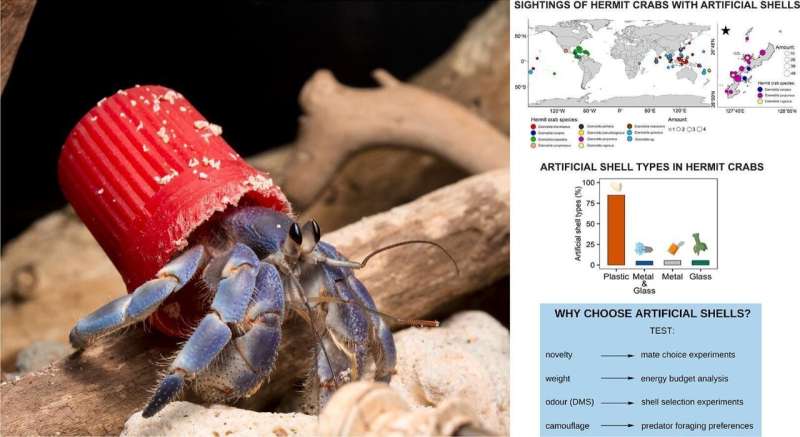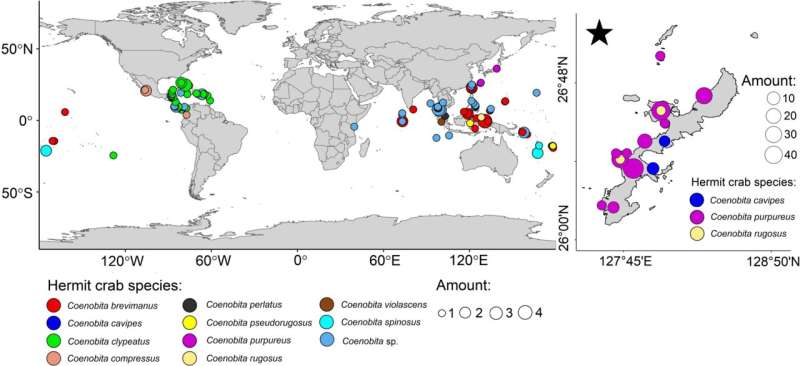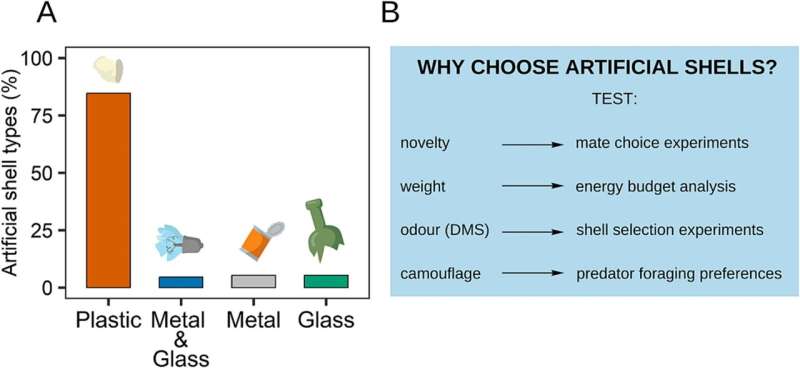January 29, 2024 feature
This article has been reviewed according to Science X's editorial process and policies. Editors have highlighted the following attributes while ensuring the content's credibility:
fact-checked
peer-reviewed publication
trusted source
proofread
On tropical coasts, hermit crabs are now making their homes in plastic waste

Terrestrial hermit crabs are soft-bodied crustaceans that live near water in the world's tropical areas. Without any natural protection of their own, these crabs normally find shelter in discarded mollusk shells. But a number of terrestrial hermit crab species are beginning to opt for artificial shells frequently consisting of plastic objects found in beach trash.
New research on this topic, described in a short communication by a team from the University of Warsaw's Biological and Chemical Research Center and the department of Zoology at Poland's Poznań University of Life Sciences, appears in Science of the Total Environment.
Plastic pollution, which is increasing, already comprises 85% of marine pollution worldwide. Existing research shows that most of the plastic pollution in Earth's oceans arrives there via rivers, leading to plastic waste accumulation on coastlines.
Terrestrial hermit crabs (Coenobitidae) live on all the world's tropical coastlines, and typically acquire empty shells of gastropods to protect their soft abdominal region, known as pleon. The shells protect them from predators and also keep their pleon from drying out.
Studies on the crabs' selection of shells have shown the main factors include chemical signals gleaned from shells; proximity of predators; quality of shells; and rate of individual crab growth. It has also been shown that shells play a role in sexual signaling, as the size and state of male crabs' shells affect females' mate choices.

An iEcology approach
In this new research, the team has taken an internet ecology (iEcology) approach. iEcology involves studying digital content—audio recordings, videos, images, news, and user activity posts—published across news sites, social media and other platforms to learn about ecological events, directions and processes.
The researchers note that "While the validity of data collected on social media platforms has been readily demonstrated in conservation, its application to ecology and evolution is still very limited."
The team acknowledges the work of photographer Shawn Miller, who first posted images of hermit crabs using plastic waste as shells on his blog in 2014, when he found blueberry hermit crabs (Coenobita purpureus) doing so on the beaches of Okinawa. It was Miller's work that inspired this study.

To quantify this kind of hermit crab behavior, the researchers reviewed images posted across several online platforms and paired their findings with a review of literature. Within their literature review, this behavior is first described in a 2009 study published in Marine Biodiversity Records.
The literature review on its own "revealed only four publications to date, reporting of two terrestrial hermit crab species, three marine hermit crab species and a total of 10 individuals with artificial shells," the paper notes.
Following the iEcology methodology permitted the team to augment their findings. They identified 386 individual crabs—from 10 of 16 total terrestrial hermit crab species—with artificial shells. Overwhelmingly, the images depicted crabs using black and white plastic caps (84.5%; 326 of 386 images). Those with shells of only metal or only glass represented 5.4% each, and the remaining 4.7% had shells of both metal and glass.
Of note with respect to the images are possible confounding factors: "...due to the often-contrasting color of plastic relative to other anthropogenic or natural materials, plastic may be easier to spot for people, thereby influencing the incidence of reporting. Additionally, data collected through iEcology may be affected by potential biases arising from various factors that influence data collection among observers. These factors include individual and cultural subjectivity, such as the likelihood of posting unusual behavior online," the paper states.

Why plastic instead of natural shells?
In discussing possible reasons for this behavior among Coenobitidae, the team notes the environmental availability of plastic waste, along with the growing scarcity of gastropod shells due to localized human activities. The researchers also suggest factors involved in individual choice, including:
- Attractiveness of artificial materials to mating females
- Lighter artificial shell weights that might benefit hermit crabs' energy
- An odor cue of dimethyl sulfide, found in both natural shells and marine waste; and
- The possibility that artificial shells may serve more efficiently as camouflage in polluted areas, given that shell selection is often made to blend into the localized environment.
These are all topics for further investigation.
The big question
"Are artificial shells setting the scene for a novel evolutionary trajectory in hermit crabs, or are they an ecological and evolutionary trap of the Anthropocene?" the researchers ask.
While this new behavior might be considered a clever adaptation, the main factor behind it is undeniable. In that vein, what this habit ultimately means for the evolution of terrestrial hermit crabs remains to be studied.
More information: Zuzanna Jagiello et al, The plastic homes of hermit crabs in the Anthropocene, Science of the Total Environment (2024). DOI:/10.1016/j.scitotenv.2023.168959
Journal information: Science of the Total Environment
© 2024 Science X Network

















